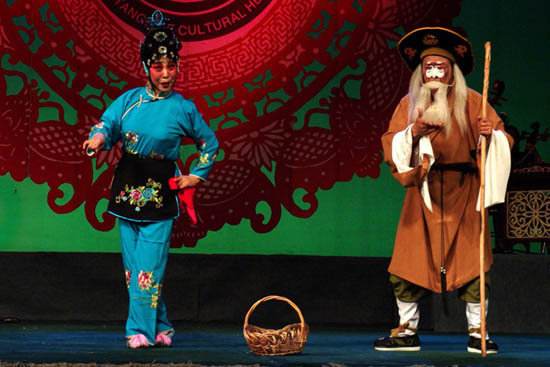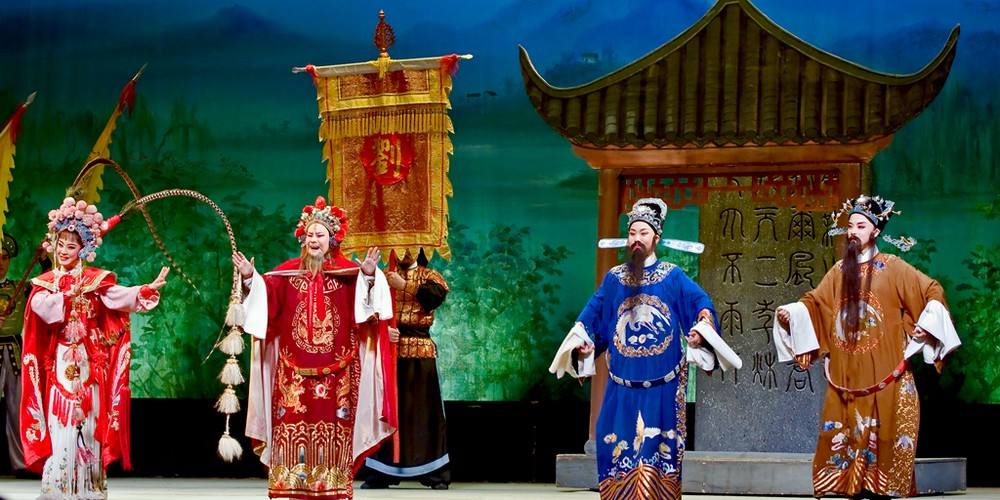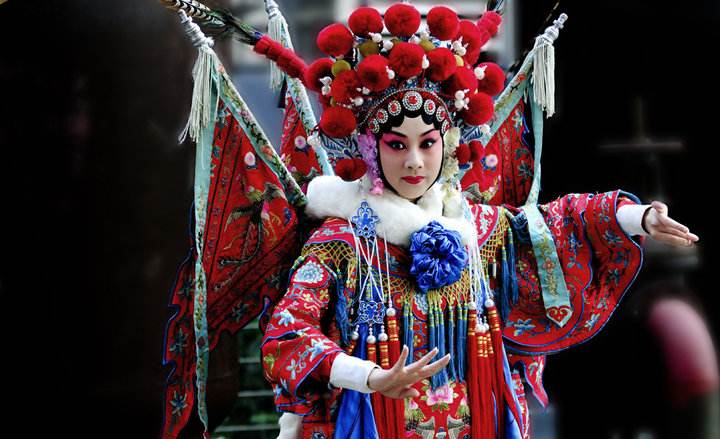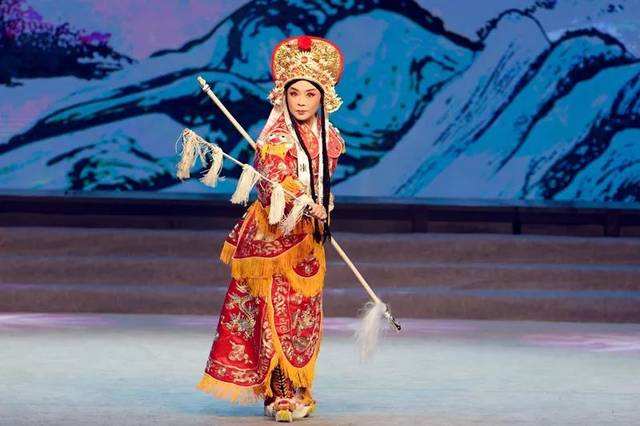Facial Makeup and Costumes
6 min read1) Facial Makeup
Many people are deeply impressed by the facial makeup of traditional opera,a way of facial dressing with different colorings and pictorial designs for different roles to denote their personalities. Mainly worn by characters of jing and chou, thevarious patterns of the facial makeup can be labeled in two types-one by coloring, the other by coloring pattern.
In the first type, there are powder white face, red face, purple face, oil white face, black face, golden-silver face, etc.
The powder white face, or molian, is made by brushing a performer’s face with white powder. Featuring rising eye corners,a beard of the same color with that of the eyebrow and the nasal pit, this pattern intimates a crafty temperament.

The red face usually symbolizes loyal and gallant generals or upright immortals. If red face is applied to a villain, that means a kind of mock. On some occasions, it is also used to meet the needs of stagecraft, for example, in the play Bailiang Pass, Liu Guozhen’s red face is to contrast the black-faced Yuchi Gong and his son.
Black-faced characters are mostly warriors, ugly in appearance yet bold and straightforward in personality. In the case of Bao Zheng, however, it means impartial and incorruptible.
Similarly, the purple face also denotes that the character is straightforward, yet not so rude compared to a black-faced character. So the disposition of a purple-faced character is somewhere between a red-faced character and a black-faced character. Sometimes, the purple face also implies that a person’s appearance is ugly, one of the examples is Pang Tong in Pay a Condolence Call in Sangcan.
The oil white face, or white face, is used by four types of characters: heroes who are old yet look ruddy, cruel warriors or self-willed generals, eunuchs, as well as stalwart monks.

Derived from the black face, the golden-silver face and the mixed-color face areusually worn by deities, indicating their faces shine with golden rays, or ghosts and monsters, suggesting their bluish green face and buckteeth. Some generals also wear this type of facial makeup.
In addition, the blue face and the green face which imply “firm yet crafty”and”brave yet feverish”respectively are also employed, but they are mostly minor roles.
Classified by how to paint, the facial makeup falls into four basic types: roulian, goulian, molian and polian.”Lian”in Chinese means “face”.
In the case of roulian, paint of different colors is brushed onto a performer’s face with fingers. With eyebrows, eyes and facial wrinkles accentuated, this pattern is more lifelike.
To draw goulian,a Chinese brush has to be used to color a performer’s face, sometimes decorated with golden or silver powder.

Likewise, molian or powder-white face paint, is painted with a Chinese brush as we11. The performer’s entire face is painted white with white powder to indicate a cunning personality.
Polian, the fragmented makeup, is one painted in a non-symmetrical fashion with derogative implications.
These four basic types of facial makeup made their presence as early as in the Qing dynasty. Since then, goulian has changed a lot, forming several subtypes such as zhenglian (whole face), sankuaiwalian (three-fragmented face), and hua sankuaiwalian(colored three-fragmented face).
2) Costume
Based on the clothing styles and fashions of the Ming dynasty, costumes in traditional opera vary from role to role in style, color, pictorial design and ornamentation. Different characters, be it a helmsman or a bartender, wear the same apparel, as long as they belong to the same type of role. The same character, however, may wear differently in two plays, if of different types. For instance, the King of Wei Cao Cao,a character whose face is usually painted white, wears hualian in Fighting in Wancheng City. The circle of traditional opera strictly observes thenorm”Better to wear shabbily than to wear wrongly.”This part is an introduction to some frequently-worn costumes.
3) Gauze Hat
There are varied gauze hats in Peking opera, which differ mainly in the shape of hat wings: oblong wings attached to a gauze hat indicate a loyal official; rhomboidal or peach-shaped wings for a treacherous official; and round wings for a corrupt or muddleheaded official. Even gauze hat with the same wings may be decorated differently to tell one character from another. For instance, the gauze hat for Zhuang Yuan(title conferred on the one who won first-place in the imperial examination) and the emperor’s son-in-law are different only in ornamentation, with the former embellished with golden flowers attached to the top and the latter with an extra pair of wings.
4) Python Robe
It is Peking opera costume embroidered with python design suitable for the roles of king, prince, general and minister. Python robes can be subdivided into many minor types: there are python robes of different colors, among which yellow, red, green, white and black are named as “upper-five colors”whereas blue, bronze, purple, pink and olive are”lower-five colors”. Pure yellow robe is for emperor only, apricot yellow robe for relatives of the emperor, including his mother, sons and others titled as prince. Red robe signifies dignity and thus is for nobilities and high officials while green robe shows bravery and fierceness and is suitable for high military officials of martial bearing. Handsome young men often wear white robe, and those who wear black robes are characterized by an upright and outspoken disposition. Nonetheless, what differentiates an emperor from a high official is not only the color but also the pictorial design of python robe: The robe worn by emperor is embroidered with a five-clawed dragon with a fire ball stuck out of his mouth while the robe worn by prince is embroidered with a four-clawed python with his mouth closed.A jade sash is necessary when male characters wear python robe.
For female characters, however, there are just three colors; yellow robe for empress, red robe for female officials, and white robe just used as the mourning appare1. Python robe suitable for the role of eunuch is the same with one for other roles except that the bottom part is two-piece.
5) Costumes for women
Costumes for women in traditional opera include pei (short embroidered cape worn over a woman’s shoulders), woman xizi (a casual gown worn by commoners from lower-middle class), skirt, trousers and ao (lined Chinese-style coat). Pei is mainly wor by ladies and young girls. Xizi worn by laodan is called laodan xizi; while the one for qingyi consist of two styles: Ladies wear fancy xizi while middle-aged women ofa poor family wear plain xizi. Skirts, trousers and jacket are also divided into two sorts, fancy and plain. The roles of ladies often wear jacket with skirt while the roles of servant girls wear jacket with trousers.
6) Kao
Made of plain satin and embroidered with colorful scales, kao, is a kind of amour worn by soldiers. Kao varies in both style and color. In term of style, there are three kinds, each worn by different roles. The hard kao or the big kao, which has a feather sheath with four triangular flags embroidered with dragons fastened to its back, is a symbol of a general. The padded kao which doesn’t have such flags are worn by aged generals. Ordinary soldiers wear transformed kao, which is similar to the padded one in style except that it has a much smaller waistline. Some transformed kaos are embroidered with scales as well. They are in various colors, including white, red, blue, purple and olive. Young generals often wear kao of a light color such as light pink, light green and light blue. Though the kao for women are more diversified than the kao for men in terms of the style, the former is not as colorful as the latter.

7) Boots
Boots has varied types: thick-soled official boots, thin-soled boots and casual boots. The sole of the thick-soled boots which have long legs made of plain satin is usually two to four cun(a unit of length which equals 1/3 decimeter) in length and painted white. Casual boots usually have simple decorations which vary to distinguish roles. For instance, casual boots for fishermen are embroidered with scales while boots for women are adorned with flower embroidery and tassel.








